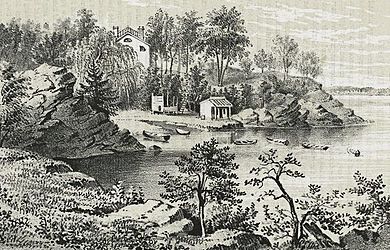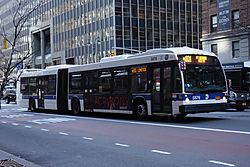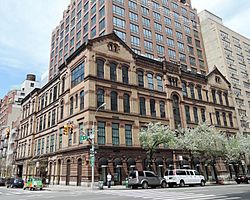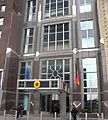Turtle Bay, Manhattan facts for kids
Quick facts for kids
Turtle Bay
|
|
|---|---|
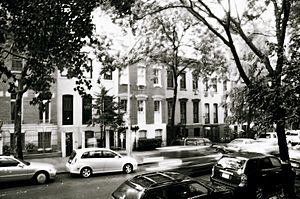
Townhouses in Turtle Bay
|
|
| Country | |
| State | |
| City | New York City |
| Borough | Manhattan |
| Community District | Manhattan 6 |
| Area | |
| • Total | 1.04 km2 (0.403 sq mi) |
| Population
(2016)
|
|
| • Total | 24,856 |
| • Density | 23,814/km2 (61,680/sq mi) |
| Ethnicity | |
| • White | 77.1% |
| • Asian | 13.0% |
| • Hispanic | 5.8% |
| • Black | 2.1% |
| • Other | 0.4% |
| Economics | |
| • Median income | $135,360 |
| Time zone | UTC−5 (Eastern) |
| • Summer (DST) | UTC−4 (EDT) |
| ZIP Codes |
10017, 10022
|
| Area code | 212, 332, 646, and 917 |
Turtle Bay is a cool neighborhood in New York City. It's on the east side of Midtown Manhattan. The area stretches from about 43rd Street to 53rd Street. It goes eastward from Lexington Avenue to the East River.
This neighborhood is famous for being home to the United Nations headquarters. It also has the amazing Chrysler Building. South of Turtle Bay, you'll find the Tudor City apartment complex.
Turtle Bay got its name from a small bay that used to be part of the East River. It was first a Dutch farm in the 1600s. Later, in the 1800s, it became an industrial area with factories and slaughterhouses. Most of these old buildings were torn down in the 1940s and 1950s. This made space for the United Nations building. Today, many countries have their offices and consulates here. They are close to the United Nations headquarters.
Turtle Bay is part of Manhattan Community District 6. Its main ZIP Codes are 10017 and 10022. The New York City Police Department's 17th Precinct patrols the area.
Contents
Exploring Turtle Bay's Past
Early Days and Its Name
Turtle Bay was once a cove, or small bay, of the East River. It got its name in the 1600s. The Dutch word "deutal" means "knife," and the bay looked like a knife. This cove was a safe place for ships during bad weather. It became a busy spot for building ships.
The land of Turtle Bay was first given to two Englishmen in 1639. This was a gift from the Dutch governor of New Amsterdam. It was called "Turtle Bay Farm" and was about 40 acres. The farm stretched from what is now 43rd Street to 48th Street. It also went from Third Avenue to the river.
A farmhouse on a hill near 41st Street was a summer home for Francis Bayard. Later, it was owned by Francis Bayard Winthrop. A creek called Turtle Creek flowed into the bay near 47th Street. To the south was Kip's Bay farm. To the north, on a cliff, was "Mount Pleasant," a house with great water views. As New York City grew, the hilly land of Turtle Bay Farm was flattened. This made way for new streets and homes.
Changes in the Late 1800s
During the American Civil War, an army office was set up at Third Avenue and 46th Street. This was where people signed up for the army. On July 13, 1863, an angry crowd burned this office down. They then caused a riot throughout the neighborhood. The New York Draft Riots lasted for three days. Army troops finally stopped the crowd, but much of the city was damaged.
After the war, the quiet neighborhood became more developed. Many brownstone buildings were built. By 1868, the bay was completely filled in. It became a busy area with breweries, gasworks, and slaughterhouses. By the early 1900s, Turtle Bay was a "backyard" for the city. It had large factories and dirty apartment buildings. These factories caused a lot of soot to fall on the area.
A huge power plant called Waterside Station was at the south end of the neighborhood. It made a lot of electricity using coal. There were also many slaughterhouses along First Avenue. With many poor immigrants moving in and new elevated train lines opening, the neighborhood became run-down.
Turtle Bay in Modern Times
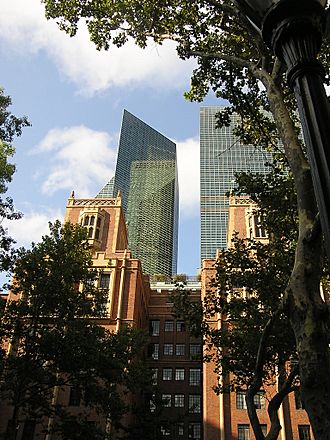
In the 1920s, many old apartment buildings were fixed up. A large shared garden was created. Charlotte Hunnewell Sorchan saw potential in the old houses. In 1918, she bought 11 houses on 49th Street and 9 on 48th Street. These were between 2nd and 3rd Avenues. Within two years, she had fixed up this area, calling it Turtle Bay Gardens.
Her architects changed the outside of the houses with light stucco. They also changed the inside so living areas faced the quiet gardens. Each backyard opened into a common garden with trees and bushes. She sold these houses to friends at cost. They agreed to rules that kept the shared garden safe. Famous people who lived here include Katharine Hepburn and E. B. White. E. B. White wrote Charlotte's Web while living on 48th Street. This area became a historic district in 1966.
An area between First and Second Avenues, from 41st to 43rd Streets, was once called "Goat Hill." It later became "Prospect Hill." This area was home to an Irish community known as "Corcoran's Roost." From 1927 to 1932, the large Tudor City apartment complex was built here. It became a historic district in 1988.

The slaughterhouses were removed to build the United Nations headquarters. This happened mostly between 1948 and 1952. Also, the elevated trains were taken down. These changes made way for tall office buildings and apartments. A staircase called Ralph Bunche Park was built. It connects Tudor City to the rest of Turtle Bay.
In 2000, there was a plan to expand the UN headquarters. Some residents were worried about losing the Robert Moses Playground. This playground was needed for a new UN building. In 2011, city and state officials agreed on a plan. The UN could build a new tower next to its current campus. In return, the UN would allow a walkway along the East River. This walkway would complete the East River Greenway, a path for walking and biking. This plan still needs approval from the United Nations.
Who Lives in Turtle Bay?
The New York City government groups Turtle Bay with East Midtown for census data. In 2010, this larger area had 51,231 people. Most residents are adults. About 45% are between 25 and 44 years old. Another 22% are between 45 and 64. About 13% are 65 or older.
The average household income in Turtle Bay was about $135,360 in 2017. This is higher than the average for New York City. About 10% of residents live in poverty. This is lower than the city average of 20%. Also, only 4% of residents are unemployed. This is less than the city average of 9%.
Turtle Bay Community Group
The Turtle Bay Association is a local non-profit group. It was started in 1957. Its first success was stopping the widening of East 49th Street. Now, the group works to help residents of Turtle Bay. It helps keep the neighborhood a great place to live. The Association has helped create more parks and green spaces. This has made the area quieter and full of trees.
Getting Around Turtle Bay
The closest New York City Subway stations are on the west side of the neighborhood. These are at Lexington Avenue/51st–53rd Streets and Grand Central–42nd Street. Grand Central also connects to the Metro-North Railroad. You can also catch many local New York City Bus lines here.
The main road on the east side of the neighborhood is the FDR Drive. The Queens–Midtown Tunnel and Queensboro Bridge are just south and north of Turtle Bay.
Important Offices and Missions
Many countries have their offices in Turtle Bay. These are called diplomatic missions or consulates. They help their citizens and work with the United States.
Here are some of the countries with consulates in Turtle Bay:
- Bahamas
- Germany
- Israel
- Jamaica
- Luxembourg
- Nicaragua
- Saudi Arabia
- Singapore
- Ukraine
- United Kingdom
Many countries also have missions to the United Nations in Turtle Bay. They are very close to the UN headquarters.
- Albania
- Andorra
- Antigua and Barbuda
- Argentina
- Australia
- Azerbaijan
- The Bahamas
- Bahrain
- Bangladesh
- Barbados
- Belgium
- Belize
- Bhutan
- Bolivia
- Bosnia and Herzegovina
- Botswana
- Brazil
- Brunei Darussalam
- Burkina Faso
- Burundi
- Cambodia
- Canada
- Chad
- Chile
- Comoros
- Democratic Republic of the Congo
- Republic of the Congo
- Costa Rica
- Croatia
- Denmark
- Djibouti
- Dominica
- Dominican Republic
- Ecuador
- Egypt
- Equatorial Guinea
- Eritrea
- Ethiopia
- Finland
- France
- The Gambia
- Georgia
- Germany
- Greece
- Grenada
- Guinea
- Guyana
- Haiti
- Honduras
- Hungary
- Iceland
- India
- Republic of Ireland
- Israel
- Italy
- Jamaica
- Japan
- Jordan
- Kazakhstan
- Kenya
- Kuwait
- Kyrgyzstan
- Laos
- Latvia
- Lebanon
- Liberia
- Libya
- Lithuania
- Luxembourg
- Madagascar
- Malawi
- Malaysia
- Maldives
- Marshall Islands
- Mauritius
- Mexico
- Federated States of Micronesia
- Monaco
- Morocco
- Mozambique
- Nauru
- New Zealand
- Nicaragua
- North Korea
- Saudi Arabia
- Tonga
- Turkey
- United States
- Vietnam
Turtle Bay in Books and Shows
Turtle Bay has been featured in many stories and shows:
- The Kurt Vonnegut science fiction novel Slapstick takes place partly in Turtle Bay.
- The cartoon show The Venture Bros. pilot episode, "The Terrible Secret of Turtle Bay", is set mostly at the UN headquarters.
- In Stephen King's Dark Tower books, a special vacant lot in Turtle Bay is important.
- The song "Stars and The Moon" from the musical Songs for a New World mentions buying a "townhouse in Turtle Bay."
- The fictional character "Mame Dennis" from the novel Auntie Mame lives in Beekman Place in Turtle Bay.
- The fictional lawyer Stone Barrington, from novels by Stuart Woods, lives in Turtle Bay.
- E.B. White wrote about an "old willow tree" in Turtle Bay in his essay "Here is New York". He said it "symbolizes the city."
Learning and Libraries
Turtle Bay residents are well-educated. Most adults (82%) have a college degree or higher. This is much higher than the average for New York City. Students in Turtle Bay also do well in school. The number of elementary school students who miss many days of school is low. Also, 91% of high school students graduate on time. This is more than the city average of 75%.
Local Schools
The New York City Department of Education does not have public schools directly in Turtle Bay.
- Students in grades PK-5 go to PS 59 Beekman Hill International in Lenox Hill.
- Students in grades 6-8 go to IS 104 Simon Baruch School in Gramercy Park.
- P.S. 135 used to be in Turtle Bay. Now, that building has apartments.
- The High School of Art and Design is a vocational school for grades 9-12.
Community Libraries
The New York Public Library has two branches close to Turtle Bay:
- The 58th Street branch is at 127 East 58th Street. It opened in 1907.
- The Grand Central branch is at 135 East 46th Street. This library opened in 2008.
Images for kids
-
The United Nations Headquarters is located in Turtle Bay; pictured is the United Nations Secretariat Building.
-
The German mission to the United Nations
See also
 In Spanish: Turtle Bay (Manhattan) para niños
In Spanish: Turtle Bay (Manhattan) para niños


